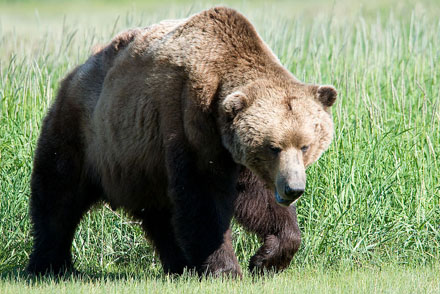 The brown bear (Ursus arctos) is a large bear distributed across much of northern Eurasia and North America. It can weigh from 300 to 780 kilograms (660 to 1,700 lb) and its largest subspecies, the Kodiak Bear, rivals the polar bear as the largest member of the bear family and as the largest land-based predator.
The brown bear (Ursus arctos) is a large bear distributed across much of northern Eurasia and North America. It can weigh from 300 to 780 kilograms (660 to 1,700 lb) and its largest subspecies, the Kodiak Bear, rivals the polar bear as the largest member of the bear family and as the largest land-based predator.
There are several recognized subspecies within the brown bear species. In North America, two types are generally recognized, the coastal brown bear and the inland grizzly, and the two types could broadly define all brown bear subspecies. Grizzlies weigh as little as 350 lb (159 kg) in Yukon, while a brown bear, living on a steady, nutritious diet of spawning salmon, from coastal Alaska and Russia can weigh 1,500 lb (682 kg). The exact number of overall brown subspecies remains in debate.

While the brown bear's range has shrunk, and it has faced local extinctions, it remains listed as a least concern species by the IUCN, with a total population of approximately 200,000. Its principal range countries are Russia, the United States (mostly in Alaska), Canada, the Carpathian region (especially Romania, but also Ukraine, Slovakia, and so on), the Balkans, Sweden and Finland, where it is the national animal. The brown bear is the most widely distributed of all bears.

The brown bear is sometimes referred to as the bruin, from Middle English, based on the name of the bear in History of Reynard the Fox, translated by William Caxton, from Middle Dutch bruun or bruyn, meaning brown (the color). During the Old West, the grizzly was termed "Old Ephraim" and sometimes as "Moccasin Joe".
Brown bears are thought to have evolved from Ursus etruscus. The oldest fossils occur in China from about 0.5 million years ago. They entered Europe about 250,000 years ago, and North Africa shortly after.

Brown bear remains from the Pleistocene period are common in the British Isles, where it is thought they outcompeted cave bears. The species entered Alaska 100,000 years ago, though they did not move south until 13,000 years ago. It is thought brown bears were unable to migrate south until the extinction of the much larger Arctodus simus. Several paleontologists suggest the possibility of two separate brown bear migrations: grizzlies are thought to stem from narrow-skulled bears which migrated from northern Siberia to central Alaska and the rest of the continent, while Kodiak bears descend from broad-skulled bears from Kamchatka, which colonized the Alaskan peninsula. Brown bear fossils discovered in Ontario, Ohio, Kentucky and Labrador show the species occurred farther east than indicated in historic records.

See Also :
- Subspecies of Brown Bear
- Grizzly - Polar Bear Hybrid
- Physical Description of Brown Bear
- Distribution and Habitat of Brown Bear
- Behavior Brown Bear
No comments:
Post a Comment